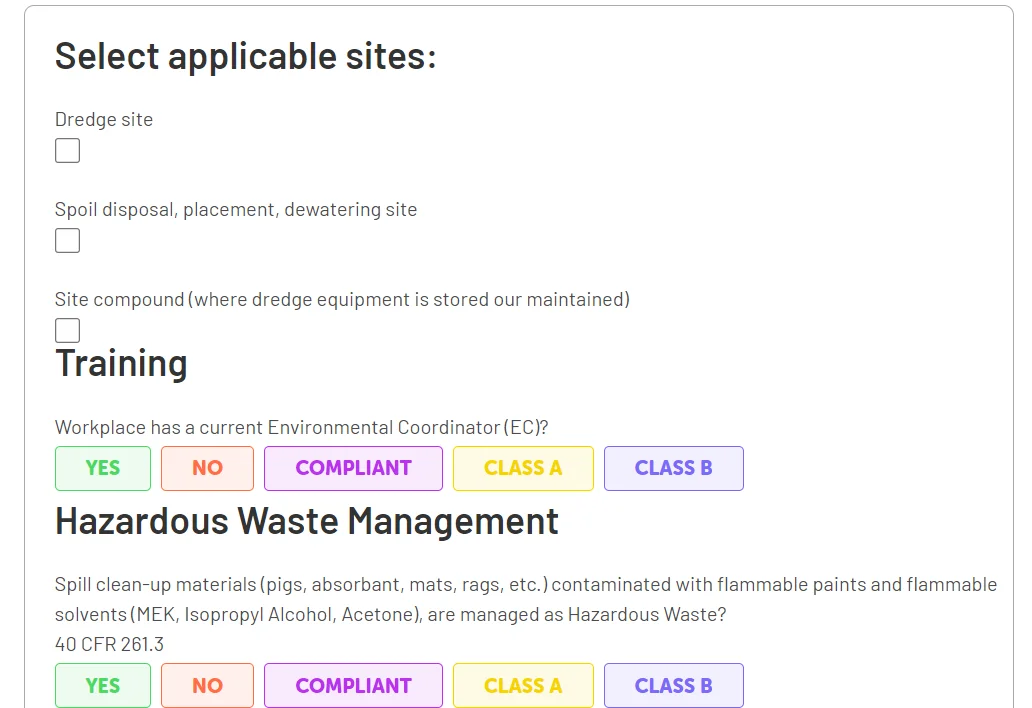What is an EPA audit checklist?
Compliance monitoring is an essential part of the Environmental Protection Agency (EPA), so they can make sure facilities and organizations comply with applicable regulations.
An EPA audit checklist guides organizations through the self-driven audit process, including how to assess whether or not resources and materials comply with environmental laws.
A checklist ensures that you’re ready for any official EPA audits, and ensures you have documentation prepared to show inspectors. Having all your documents gives you confidence in case the EPA inspection is a surprise.
How should you prepare your EPA audit checklist?
According to EPA statistics, companies spend as much as $63 million in combined civil, administrative, and criminal fines, and as much as $9.7 billion in actions and equipment that curb pollution and clean contaminated areas.
Your organization can avoid paying hefty non-compliance fines if you prepare a comprehensive EPA audit checklist that covers every regulation.
Prepare the following information and documents:
- Facility map and description
- Organization’s regulatory history
- Current compliance programs of your organization
- Compliance procedures/process records
- Employee training records
- Medical examination records
- Existing environmental licenses and permits
A key part of any EPA audit checklist is your corrective action plan. You need to be aware of the things that need fixing and the ways you could fix them.
Have a regular schedule for the following tasks:
- Visual inspections of your plant/facility
- Interviews with selected facility personnel
If certain areas in your facility have been flagged for non-compliance during an inspection, acknowledge them. Also, describe the corrective actions you will take to comply.
Identify the following processes, issues, and materials:
- The main operation at the plant/facility, including all applicable codes like the Standard Industrial Classification(SIC) code
- Potential sources of pollution in the workplace
- Raw materials used in the plant
- Waste and pollution control devices and processes
- The installation date of each process
- Accident history
Familiarize yourself with all the machinery and equipment used in the facility. Be aware of any machinery using fluids that have PBCs.
Know your organization’s environmental management history. You should be able to identify all the types of wastes produced by the facility.
Review all records and files related to your environmental management program documents regularly. Find out if any of them are still valid or near expiration. Some of these documents might include:
- Permits and documentations
- Flowsheets
- Sampling records
- Maintenance and operating logs
- Emergency action plan
- Notification procedures
- Analytical inventories
Finally, make sure to address the following questions:
- Is there a written protocol that guides employees on how to respond to an inspection?
- Do you know your organization’s point of contact?
- Do you have all copies of all the required permits, forms, and regulatory submissions?
- Do you have a dedicated place to store all the confidential and privileged documents?
The most common violations addressed by an EPA audit checklist
Several mistakes make up common shortcomings that companies neglect to address and which lead them to face repercussions from regulatory bodies. The most typical violations that result in investigations include, but are not limited to:
Improper removal and disposal of regulated asbestos
Although banned in several countries, asbestos is legal in the United States. However, it’s regulated because it does pose a significant health risk. The law includes strict requirements for the removal and disposal of asbestos. Not following those guidelines constitutes a violation of the EPA’s Clean Air Act.
Unlawful pollution of water sources
The Clean Air Act requires plants or facilities to treat wastewater first before flushing it into the sewer system. Skipping this step is harmful to the environment and you can have your operating permit revoked.
Illegally dumping hazardous waste
Hazardous waste comes from different sources, such as harmful chemicals, industrial wastes, and hospital waste. Disposing of hazardous waste inappropriately is not only toxic to the environment, but also to public health.
The EPA advises organizations to identify these substances using a hazardous waste identification process. That way, they can be disposed of properly.
Unlawfully importing restricted chemicals
An EPA audit checklist helps organizations identify whether the chemicals they import or use violate environmental laws. These hazardous chemical wastes include:
- Batteries containing mercury
- Pesticides
- Paints
- Fluorescent bulbs
- Industrial solvents
- Chemical pollutants – arsenic, lead, copper, radionuclides
- Microbial – coliform, disinfectant byproducts, etc.
- Right-to-know – the idea that consumers have a right to know the quality of their drinking water
- Resolve incidents up to 4x faster than before thanks to more efficient team communication and faster incident reporting
- Turn any existing paper checklist into a digital one in minutes using the flexible form builder
- Include photos and comments to improve the quality of your inspections
- Address issues and violations immediately, and assign corrective actions on the spot
- Use automatically generated inspection reports to analyze your audit results and avoid having to enter all that data manually
Tampering with drinking water
The penalty for tampering with a drinking water supply is 20-year imprisonment. The EPA sets legal limits on more than 90 contaminants that can be harmful to drinking water. These contaminants are divided into three categories:
Having an EPA audit checklist and monitoring compliance regularly helps businesses evaluate their environmental status. It also helps eliminate work hazards and costly penalties.

Simple EPA audit checklists with workflow automation software
Ensuring compliance with EPA regulations is easier when you use workflow automation software to generate and manage your EPA audit checklists. As opposed to paper-based checklists, automated checklists are digital, meaning they are reusable and don’t need to be stored anywhere
Lumiform’s app and desktop software store all your inspection data securely and helps you track corrective actions in case any issues are identified. When you start using it to perform internal EPA audits, you can:


